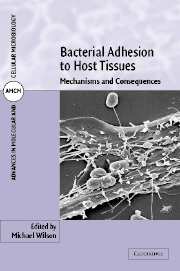Book contents
- Frontmatter
- Contents
- List of contributors
- Preface
- Part I Bacterial adhesins and adhesive structures
- 1 Surface protein adhesins of staphylococci
- 2 Mechanisms of utilization of host signalling molecules by respiratory mucosal pathogens
- 3 Adhesive surface structures of oral streptococci
- 4 Regulation and function of phase variation in Escherichia coli
- 5 Regulation of capsule expression
- 6 Role of pili in Haemophilus influenzae adherence, colonization and disease
- Part II Effect of adhesion on bacterial structure and function
- Part III Consequences of bacterial adhesion for the host
- Index
- Plate section
4 - Regulation and function of phase variation in Escherichia coli
Published online by Cambridge University Press: 08 October 2009
- Frontmatter
- Contents
- List of contributors
- Preface
- Part I Bacterial adhesins and adhesive structures
- 1 Surface protein adhesins of staphylococci
- 2 Mechanisms of utilization of host signalling molecules by respiratory mucosal pathogens
- 3 Adhesive surface structures of oral streptococci
- 4 Regulation and function of phase variation in Escherichia coli
- 5 Regulation of capsule expression
- 6 Role of pili in Haemophilus influenzae adherence, colonization and disease
- Part II Effect of adhesion on bacterial structure and function
- Part III Consequences of bacterial adhesion for the host
- Index
- Plate section
Summary
INTRODUCTION
Expression of the majority of proteins and other cellular constituents within bacteria such as Escherichia coli appears to be homogeneous within the bacterial population, changing only in response to specific alterations in the environment. Moreover, for most cellular properties, environmental change appears to elicit a uniform response from each cell. However, for a subset of genes, expression is restricted to a fraction of the population. In this more unusual mode of gene regulation, termed phase variation, individual cells switch between expressing (ON) and non-expressing (OFF) states reversibly at frequencies that can be as high as one switch per cell per generation to one switch per 10,000 cells per generation. Thus, at the level of an individual cell, it appears that, in molecular terms, one or more of the steps that are required for phase switching occurs at a low frequency. Furthermore, phase variation appears to be a random or stochastic process. According to this hypothesis, the molecular events leading to phase switching occur with equal probability for each cell in a given phase over the course of the cell cycle. As described in more detail below, phase variation is nevertheless regulated in most (if not all) phase variable systems in E. coli in response to specific environmental signals. Where regulation does occur, it seems likely that switching still occurs at random, even though the regulation results in switching at a different frequency. In the related phenomenon of antigenic variation, different cells express variants of the same protein or other macromolecule.
- Type
- Chapter
- Information
- Bacterial Adhesion to Host TissuesMechanisms and Consequences, pp. 89 - 114Publisher: Cambridge University PressPrint publication year: 2002
- 5
- Cited by



